Porta Day is a holiday…Porta Day is my favorite day…cause on Porta Day we get to walk around the entire city which turns out to be abut 5 miles and see more of the awesome things that Bologna has to offer and take lots of cool pictures of interesting things! Okay, so my Porta Day lyrics don’t quite sync up to “Scrubbing Day” from the movie Pippi Longstocking, but still, Porta Day was an awesome day and it needs its own song.
What is Porta Day you ask, it’s just the day that Brittany and I decided to walk around the town where, at one point in history, a wall surrounded the entire town. There are still several sections of the wall that are intact, and 10 porte still stand (kind of…but we’ll get more into that as this blog progresses). Oh, porta is the Italian word for door (or porte for doors). So we took a trip around the city to follow the path the old wall and doors into the city followed. Ready for some history? I hope so, cause these “doors” are really interesting.
Museo Civico del Risorgimento
Before we even got started, in fact, before we even got to the street that circles the city containing the wall and porte, we ran across a hill with several interesting statues. There was a fence separating us from the statues, but we still managed to get some photos. Turns out, the area is actually the Museo Civico del Risorgimento. (According to Dictionary.com risorgimento is “the period of or the movement for the liberation and unification of Italy.”) It was closed, but know we know where to find it…and we’ll be back.
A quick side story: I love gargoyles, and all other creepy statues lurking in hard to reach / hard to find places. I try to get pictures of them where ever we go. There aren’t many in Bologna (that I’ve found so far), but I also like their less-hidden cousins. Like this lion. He sits on several fences around the city, I’ve kind of made it my side mission to photograph him at all of his locations. So enjoy!
As luck would have it, the starting point of our journey lay just behind the statued hill. There we found our first section of the city wall that once circled Bologna. Each wall has a placard on it that says “Mura della Città – Avanzi dell’ultima cerchia murata costruita new secoli XIII – XIV; fu demolita in gran parte agli inizi del Novecento.” (City Walls – Leftovers of the last ring of walls built new in the 13th and 14th centuries; It was largely demolished in the early twentieth century.)
Brittany and I both really love how buildings and other such structures are often integrated right into the wall remains; but, more often than not, the section just stops dead. Making way for a street or sidewalk. It’s really neat to see the wall/porte just end like this because you get to see the make up of the structure. Although it is also kind of saddening because, with a little research, you find that a good portion of these pieces of history were torn down to make way to accommodate modern needs (i.e.- wider roads, buses making sharp turns, etc.).
This isn’t part of the wall, but rather just an image to show how beautiful our little trip was as the leaves begin to turn. FYI…for those of you that I’ve talked to about the narrowness of all the roads, this is the exception. This road, though called different things along the way, accommodates most of the traffic while getting around the city. This is not the norm once you enter it.
Porta di Strada Maggiore
And just a short distance away from our first wall, we get our first porta – Porta di Strada Maggiore.
We tried to get a perspective shot with as many of these things as we could. Some are so close to the road that you can’t even get a good photo much less one with any perspective. But for Strada Maggiore, Brittany demonstrates its size.
The placard on the porta states “La porta appartiene alla terza e ultima cerchia delle seconda metà del XIII secolo. Fu ridisegnata nel 1770 da Gian Giacomo Dotti e ridotta nelle forme attuali, sulla base dei resti ritrovati dopo la demolizione dei primi del Novecento, secondo un progetto di Alfonso Rubbiani.” (The gate belongs to the third and final circle of the second half of the thirteenth century. It was redesigned in 1770 by Gian Giacomo Dotti and reduced in its present form, based on the remains found after the demolition of the early twentieth century, according to a draft by Alfonso Rubbiani.)
According to one of my favorite Bologna websites, Bolognawelcome.com, it is also called the “Gate of honor” because “many sovereigns and popes have crossed under this gate.” To clarify the porta placard, the website also states that it was built in the 13th century and then “rebuilt” in the 14th and 15th centuries. I’ll have to do some research about what “rebuilt” really means…was it completely torn down or just in need of some repairs? It goes on to say, as the placard says, that it was again “rebuilt” in 1770, and that in 1903 it was decided that the gate would be torn down, but demolition was stopped in 1909 after a “long and heated debate.” It finishes by by saying that pieces of the demolished porta were saved and restored by the Committee of artistic and historical Bologna.
Knowing this now, I’d like to know how much was left when the demolition stopped and what pieces had to be re-lego-ed. Regardless, it’s really beautiful and I’m glad that it was restored. The site also says there was once a long bridge over a moat at this porta…kinda bummed it didn’t survive.
We actually stumbled upon this porta our first day of exploring, but really didn’t know what we were looking at. Apparently, we also didn’t bother looking past the porta or we would have seen just how incredibly close to le Due Torri we actually were.
Across the street we could very clearly see both sides of the next section of city wall. Like this porta, we stumbled into this section of the wall in the same initial days. It really is beautiful and stunning to see the ancient architectural skills.
And while I have my tiny lion statues, Brittany has benches. I love my little lions, but I will admit she has a great eye for simple beauty.
Porta San Vitale
The next porta, which was really close to the first, was Porta San Vitale.
Again, we couldn’t get far enough away from the structure to really get a good photo from every angle (unless we wanted to get hit by a car).
The placard on this porta reads “La porta appartiene alla terza e ultima cerchia delle mura delle seconda metà del XIII secolo. Portata alle forme attuali in seguito a molteplici rimaneggiamenti venne privata dell’ avancorpo, o rivellino, nel 1952.” (The gate belongs to the third and final circle of the walls of the second half of the thirteenth century. Brought to its present form as a result of numerous changes and was deprived of the avant-corps, or ravelin, in 1952.)
So what exactly does that mean? No idea. Time for a bit of research on Bologna Welcome. According to the site, this porta is also called “Gate to Ravenna” because it leads to Ravenna, which was the “antique capital of the Roman Empire.” It further states that the porta was built in 1286 along with “a powerful tower – destroyed at the beginning of the 16th century.” Additionally, it says “the gate was reduced in 1950-1952 when the ravelin and the external avant-corps were demolished.” Hopping over to Wikipedia let me know that a ravelin is “a triangular fortification or detached outwork” and avant-corps refers to “a part of a building that juts out from the principle portion.” Also, like the previous porta, this gate once had a drawbridge over a moat.
Again, for some perspective, here’s Brittany standing beside the porta‘s door.
And then me standing beside the door within a door (also called a wicket…knowledge is power!).
Porta San Donato
This porta was completely new to me, but Brittany had seen it a few times because it is very near her school; however, she hadn’t really stopped and looked at it…just saw it in passing. One of the great things about this one (other than its size) is that on three sides you can stand pretty far back to get a shot. The other side…not so much. In fact, in the first image, you can see just how close the right hand side is to the street.
This placard says “La porta appartiene alla terza e ultima cerchia delle mura della seconda metà del XIII secolo. Venne trasformata nel XV secolo e conserva ancora l’ antico avancorpo o rivelino.” (The gate belongs to the third and final circle of the walls of the second half of the thirteenth century . It was transformed in the fifteenth century and still preserved the old avant-corps or ravelin. – see previous porta for definitions of avant-corp and ravelin)
The interior portions of this porta were gated, but you could still get a pretty good view of the inside.
So what does good ol’ Bologna Welcome have to say about this one? Well, first off, that Porta San Donato used to have a drawbridge and moat too! Man, to have seen these things in their glory days! It also discusses the various times the gate was shut-down and reopened through its existence, as well as the fact that there was apparently another gate (San Giacomo) south of this one that was walled up in the 14th century. Finally, there is reference to this porta almost being demolished several times between 1952 and 1959 to make room for the roads, but apparently “one meter of wall was destroyed after a heated debate to resolve traffic problems.” So glad they left it standing.
And here’s our perspective shot. Can’t tell? That’s because I’m so tiny standing in its entranceway. M-A-S-S-I-V-E.
The next portion of the wall started just across a small sidewalk/bicycle path. This was the largest section that we had encountered so far. In fact, it was so large that the only way to get a good photo of it was to cross the street.
This is looking left, back toward the Porta San Donato.
And this is looking right…into the future I suppose…
While we were across the street, we decided to venture a bit since neither of us had been outside of the walled section of the city since arriving. This is a view of the more modern Bologna from Via Camillo Ranzani.
Back to our wall – this is the end of this portion of the wall. On the back (interior) side of the wall, the land actually slopes up to meet the top of the wall.
Porta Mascarella
We quickly found our next target, Porta Mascarella. As you can see in the first image, this porta was completely surrounded by street.
This placard said “La porta appartiene alla terza e ultima cerchia delle mura della seconda metà del XIII secolo. Sono visibili resti della costruzione originale, poi rimaneggiata e abbassata nel corso del XVI secolo. Fu isolata agli inizi del Novecento, a seguito della demolizione delle mura.” (The gate belongs to the third and final circle of the walls of the second half of the thirteenth century. There are visible remains of the original construction, altered and lowered during the sixteenth century. It was isolated in the early twentieth century, following the demolition of the walls.)
Bologna Welcome says, as usual, it had a drawbridge and moat (catching on to a theme?), and that “its location was considered risky and it had to be reinforced repeatedly.” There was also apparently a tower at this porta as well, but it was “demolished in 1511 because of the risk to be hit by the artillery.”
I’m not going to lie here…we were a little distracted at this particular porta. There was a very large, fenced in area across the street from its location that caught our attention. We’re still not sure what was behind all the veiled sections, but whatever it was, it was huge…and secretive.
Also, within this porta lived the fattest pigeon that either of us had ever seen. And directly below him, the biggest pile of pigeon feces that anyone has ever seen. That along with the fact that there wasn’t much room around the porta meant that we didn’t get a perspective shot.
We crossed the street onto Via Stalingrado to check out said veiled area, but got no more information. While we were there though, we did snap another photo of the city. We weren’t sure what the green-roofed building was, but we were determined to keep it in our sites so that we could go exploring.
And while across the street, we grabbed another shot of Porta della Mascarella.
There was a pretty good walk from Mascarella to our next porta, and you could tell you were coming into a more modern part of the city. There were lots of gas stations and souvenir shops and what-nots. But eventually we did reach the city wall again, and the Castello di Galliera.
Castello di Galliera was a site we had visited previously, but since it was along the way, we thought we would include it. Its placard stated “Questi ruderi sono ciò che rimane dell’ antics fortificazione cittadina, costruita e distrutta cinque volte. La prima fortezza venne innalzata dal Cardinal Legato Bertando del Poggetto nel 1330-32 e distrutta con la sua cacciata nel 1334; nella cappella trecentesca vi erono affreschi di Giotte e un polittico marmoreo di Giovanni di Balduccio (1334 c.). L’ ultima construzione, con fossato e otto torrioni di guardia, venne eretta per volontà di Giulio II nel 1507 e distrutta nel 1511.” (These ruins are what is left of ancient city fortifications, built and destroyed five times. The first fortress was erected by the Cardinal Legato Bertando of Poggetto in 1330-32 and destroyed with his expulsion in 1334; in the fourteenth-century chapel there were frescoes by Giotte and a marble polyptych of Giovanni Balducci (1334 c .). The last building, with moat and eight guard towers, was built by order of Julius II in 1507 and destroyed in 1511. {According to Dictionary.com, polyptych is “a work of art composed of several connected panels.”})
Tempio del Sacro Cuore
And then, in the same area, was the Porta Galliera, but since we had visited this area in the past, we chose to go across the bridge to find our green-roofed building first.
We crossed into yet another section of town we had not previously explored. This section was significantly newer, but still had the same Bologna charm. Our green-roofed building turned out to be a church called Tempio del Sacro Cuore (Temple of the Sacred Heart).
I didn’t take too many pictures since the shutter on the camera is so loud, but I did manage to get these two.
And Brittany snapped these using her cell phone.
Umm…what is that you ask? Creepy. The answer you’re looking for is creepy. Actually, it’s a really interesting piece of art titled L’Uomo Velato (The Veiled Man). There is also a youtube video showing the piece at different angles here.
We also found this small scale version of the church.
Okay…so large small scale…
Porta Galliera
Back across the bridge we went, straight to the Porta Galliera. This porta is directly across the street from the train station, and it was very full of people. While we didn’t personally pose for a perspective shot, there were plenty of people to do it for us.
If you’ve been following along with us on our journey, you might remember that we’ve been here before…remember these guys?
Porta Galliera‘s placard reads “Costruita su progetto di Bartolomeo Provaglia (1659-61) è una delle più elaborate e complesse porte dell’ ultima cerchia di mura. Si presenta con due fronti di disegno assai dissimile: quello interno di fastosa e scenografica architettura barocca, quello esterno di carattere severo, che ne accentua la funzione difensiva. Venne isolata agli inizi del Novecento, a seguito della demolizione delle mura, e successivamente restaurata nel 1926.” (Built and designed by Bartolomeo Provaglia (1659-61) it is one of the most elaborate and complex gates of the last ring of walls. It has two very dissimilar styles: the inside of sumptuous and spectacular Baroque architecture, the external character severe, that accentuates its defensive function. It was isolated in the early twentieth century, following the demolition of the walls, and then restored in 1926.)
According to Bologna Welcome, the porta is also called the “Gate of the hostile fortress” because of the nearby Castello di Galliera, which, again, “was destroyed and rebuilt 5 times between 1330 and 1511.” The site continues by stating that this porta is significant because it “was the entrance of the convoy of vessels coming from the river port.” This is strange seeing as there is no water near this porta anymore…or is there. Many of the canals and waterways in Bologna have been covered and paved over. If you look a bit closer at this porta you find evidence of this.
Because of its style, sheer beauty, and location, we both really like this porta (and Brittany loves her statues!) It is astonishing from every angle.
Salara
As usual, during our little escapades, we always manage to find a few beautiful things unintentionally…like the Salara.
The building was once a salt warehouse, but now provides a fairytale-like entrance to the Parco del Cavaticcio (Cavaticcio Park).
For those of you keeping score at home…that’s 5 porte down and 5 to go.
If you’ve made it this far, go a little further with us. There’s still plenty of beautiful sights to come.
After leaving the Salara, the city wall picked right back up. This section of the wall was severely deteriorated, but in spite of, or because of, it is still immaculate.
Porta Lame
Next we found the Porta Lame, which sported a couple of bonus finds.
The placard associated with this porta says “La porta, costruita su disegno di Agostino Barelli nel 1677, appartiene alla terza e ultima cerchia delle mura. Le statue bronzee dei giovani partigiani, di Luciano Minguzzi, ricordano una battaglia avvenuta nei pressi della porta il 7 novembre 1944.” (The gate, built and designed by Agostino Barelli in 1677, belongs to the third and last city walls. The bronze statues of young partisans, by Luciano Minguzzi, reminiscent of a battle that took place near the door on Nov. 7, 1944. {partisans-fighters that do not belong to the army but rather a movement of resistance})
According to Bologna Welcome, the gate that originally stood at this location was built in the 13th century with, not one…but two drawbridges! “One for pedestrians and one for carriages.” It states that this porta is also called the “Water Gate” because “of the many lakes and marshlands outside of the gate (lame in Latin means marshland).” It goes on to say that the porta was “radically rebuilt in 1674 and 1677 when the medieval keep was demolished.” It finishes by revealing the meaning of the two statues, which is dedicated to “the victory of partisans against the Nazi troops after long fights in November 1944.”
These statues were pretty huge as well.
Everything here seems to have a beautiful, and sometimes tragic, story.
Since we were on the opposite side of town we decided to throw in another shot of how gorgeous the city is. This is the bike lane that runs down the center of the main road encircling Bologna.
And back to the wall! This time though, the wall held a pleasant surprise for us.
There was a small park behind this wall, which meant we got to see the other side up close!
Porta San Felice
The next porta on our journey was Porta San Felice. While we were taking photos of this porta, we got some pretty odd looks from the passengers on a bus that was passing by. But, as you can see from the next two photos, there is barely enough room to squeeze by without walking on the road.
And we remembered to take our perspective shot. Though tiny, I assure you she is happy!
This placard said “La porta appartiene alla terza e ultima cerchia delle mura della seconda metà del XIII secolo. Ristrutturata nel 1508 da Antonio Paltroni, fu isolata agli inizi del Novecento, a seguito della demolizione delle mura.” (The gate belongs to the third and final circle of the walls of the second half of the thirteenth century. Renovated in 1508 by Antonio Paltroni, it was isolated in the early twentieth century, following the demolition of the walls.)
And what does Bologna Welcome say about this porta? The gate was built in the 13th century and a “fortress and a drawbridge were added in 1334.” It also refers to the porta as the “Gate of the War” because it has been involved in so many wars though out the centuries. It goes on to say that “it was restored on the occasion of the visit of Napoleon in 1805.” And this last piece will need further research on my part, but it states that “one of the famous moments of its history is the affair of the “stolen bucket” taken by soldiers of Modena from the spring near the gate San Felice as their spoils of war after their victory in the battle of Zappolino in 1325.” Hmmm…a stolen bucket?!? Maybe “bucket” means something different here.
Chiesa di Santa Maria e San Valentino della Grada
Again and again we stumble onto astonishing things we never would have thought to look for. We thought we had just found another piece of the wall, but we ended up with so much more.
We couldn’t find any information about this place at first, but the hidden canal was fantastic. Brittany and I both liked the metal grill that could be lowered into the water or, as in the picture, raised. Apparently through these grills is how the “Reno Canal entered the walls of the city and was mainly used to prevent possible enemies to enter the city.” As usual, my source is Bologna Welcome.
This next photo is the area directly above the area in the previous photo.
Also according to Bologna Welcome, “The Church of Santa Maria e San Valentino della Grada is famous above all because it preserves the remains of the priest and martyr San Valentino.”
These final two photos are taken from the other side, where the canal exits the tunnel.
Just a beautiful sunny afternoon in Bologna, Italy.
Actually, I’m thankful for the church and the beauty of the city because the next porta, Porta Sant’ Isaia, is no longer there. So it was quite the walk between the porte at this point.
Porta Saragozza
But we did manage to finally reach Porta Saragozza, and honestly, it was worth a little extra walking to get to this one. Saragozza felt more like a palace than a city gate.
While not my little lion friends, these guys are still impressive.
This porta was so large that it has its own portici.
The placard with Saraozza says “La porta appartiene alla terza e ultima cerchia delle mura della seconda metà del XIII secolo. Il complesso venne modificato radicalmente, con l’ aggiunta di due torri circolari, dall’ ingegnere Enrico Brunetti Rodati (1857-59).” (The gate belongs to the third and final circle of the walls of the second half of the thirteenth century. The complex was radically changed, with the addition of two circular towers, from the engineer Enrico Brunetti Rodati (1857-59).)
Bologna Welcome also calls this porta the “Holy Gate” or the “Gate of Pilgrims” because “the gate has been an important point on the way to the hill Colle della Guardia and to the Sanctuary of Beata Vergine di San Luca (Virgin Mary of San Luca) – the goal of many processions and pilgrims.” It also had a drawbridge and a moat (can you hear the disappointment in my voice?) added in 1334. The site also states that the portici were added in 1859 to join the two towers.
A closer look at my not-so-little lion friends.
Brittany and I had wondered to this porta on accident once before (sans camera) while we were looking for the Chaplin Cinema, which apparently plays English movies once a week. I’m glad we came back with a camera…
There was another fairly significant gap between Saragozza and the next porta, Porta Castiglione, because the porta between the two, Porta San Mamolo, is no longer there. I’m kind of sad about this one because, once again according to Bologna Welcome, Porta San Mamolo was built in the 12th century. Grrr…”a drawbridge over the moat was added in 1334″ and “despite its full restoration in 1850, the gate was demolished in the fever of ‘progress’.” Just one moat…that’s all I’m asking for…with some tiny lion statues…but that’s it…and maybe a drawbridge…
Back to the wall…
This section of the wall was pretty neat because it had a little door presumably leading to a canal. I say that because the sign at this wall had a map of the hidden canals of Bologna.
Nature taking back its territory….
On the final leg of our journey…one final look at how perfect Bologna is going to be in the Fall.
Porta Castiglione
By the time we finally reached Porta Castiglione, the next to last porta, there’s no lie to tell…we were both tired, thirsty, and in desperate need of a comfy seat. Again, not much room to maneuver around the base, but this first photo is our prospective shot.
Its placard stated “La porta appartiene alla terza e ultima cerchia delle mura della seconda metà del XIII secolo. È stata rimaneggiata agli inizi del XV secolo e portata alle forme attuali nei primi anni del Novecento, a seguito della demolizione delle mura.” (The gate belongs to the third and final circle of the walls of the second half of the thirteenth century. It was remodeled in the early fifteenth century and brought to its present form in the early twentieth century, following the demolition of the walls.)
Pretty straightforward, but let’s see what Bologna Welcome has to say about it. This gate is also called the “Gate of Canals” because “there was a canal that allowed the Savena river to enter into the town.” Hmmm…also pretty straightforward, but this information probably means that the door in the city wall that we thought lead to a canal is most likely the canal being referenced.
Found this cool little guy just hanging out behind some bushes.
I love random acts of art.
And even more city wall!
Oh but wait, this one holds a surprise! Behind this city wall is a rather interesting church. Surprisingly Bologna Welcome offers me no information about this church, luckily I snapped a photo of its placard. (Yes, placards are on everything…because everything is freaking ancient.) It is called the Santuario della Madonna del Baraccano, and the placard basically stated that the sanctuary was built in 1418, resting on a section of the wall.
These statues adorned the front facade of the sanctuary.
And a different angle of the statue holding Le Due Torri.
And all of them in their places.
This was a door and wall to the left of the church entrance. It just screams ancient, and we love it for that reason.
And somehow we managed to make it back to our starting point. Yay!!! tiny little lion statues again!
Hold on now, if your on porta duty, you should have only counted 9 porte when there should be 10…right? Well that’s because we somehow missed one! And as exhausted as we were, we wanted to complete our Porta Day journey. So we looked up Porta San Stefano and backtracked.
Now, if this were a novel I would tell you to stop reading at this point. End on a happy note and walk away, but, if you’re like us and need finality, keep going. But you’ve been warned.
Porta Santo Stefano
Turns out, we had, in fact, already passed Porta Santo Stenfano. It just looked so different from the other porte, we didn’t realize what it was. In hindsight, we should have started here and worked our way around. Now we know.
So…taadaa…here is the final porta…in all its…glory…
Santo Stefano‘s placard reads “Gli edifici attuali, che sostituiscono la porta medioevale, furono eretti nel 1843 dall’ architetto Filippo Antolini per ordine di Papa Gregorio XVI. La barriera daziaria era chiusa da un cancello, poi trasferito all’ ingresso dei giardini Margherita presso porta Castiglione.” (The current buildings, replacing the medieval gate, were built in 1843 by architect Filippo Antolini by order of Pope Gregory XVI. The toll barrier was closed by a gate, then transferred to the entrance of the Margherita gardens at Castiglione gate.)
So the current buildings were built in 1843, replacing the porta…sigh…Bologna Welcome says the original gate was called the “Gate to Tuscany” and was built in the 13th century. It also states that, before being destroyed by artillery in 1512, there was a tower here. It makes no mention of a moat…
Don’t get me wrong, these two buildings are interesting, but compared to all the others…just disappointing. And to add insult to proverbial injury…both serve as stores now. And they didn’t look like interesting stores…just normal tobacco stores…sigh
Ah well…
Hooray for tiny LIONS!
Well that was our exploration of all the porte around the outer wall of Bologna. We laughed, we cried, we nearly soiled ourselves…seriously, that thing at the Tempio del Sacro Cuore was creepy! Anyway, I apologize that this blog was so long, but there is so much to see in this wonderful city.
And the best part…your day can always end with gelato!
Italian word of the day: leone – lion (because, well other than the obvious, the Bologna Coat of Arms has a lion on it…there…I made it work!)





















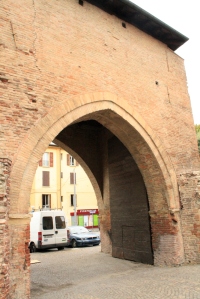
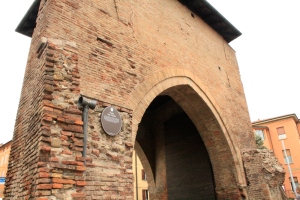


















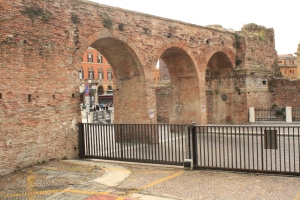








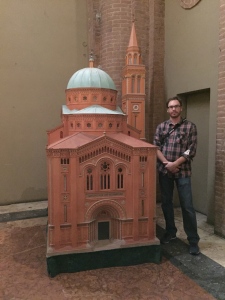


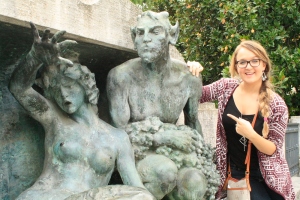












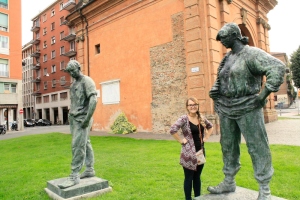

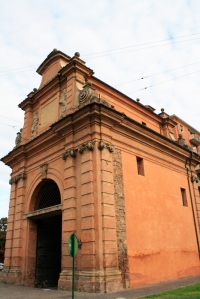









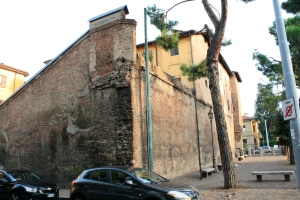















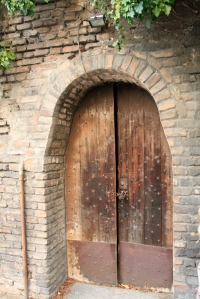











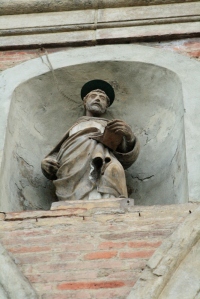

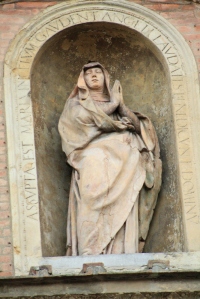



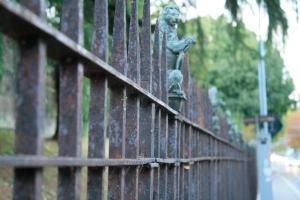




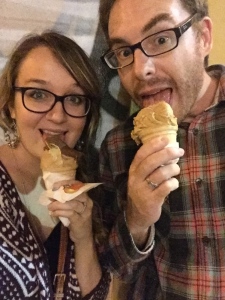
2 thoughts on “September 27, 2015”